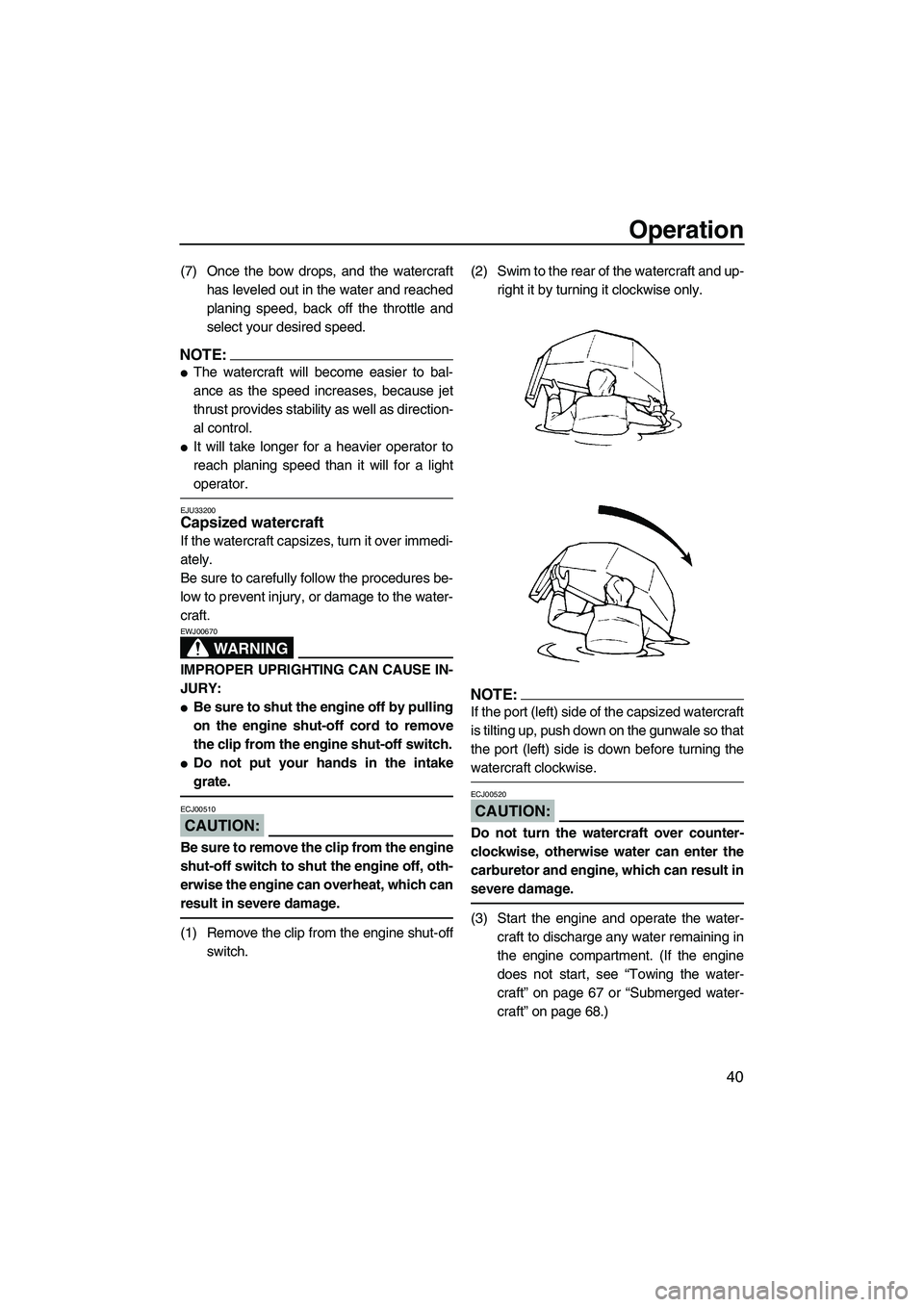Page 25 of 78
Features and functions
18
To install the hood:
(1) Position the hood on the deck so that the
two projections at the front of the hood fit
under the two stays on the deck.
(2) Push down on the hood latch, and then
turn the knob to the lock position.
NOTE:
Make sure that the hood is properly secured
before operating the watercraft.
EJU31090Fuel tank filler cap
To remove the fuel tank filler cap, turn it coun-
terclockwise.
NOTE:
Make sure that the fuel tank filler cap is se-
curely closed before operating the watercraft.
EJU31120Fuel cock knob
The fuel cock supplies fuel from the fuel tank
to the carburetors.
1Fuel tank filler cap
UF2F70E0.book Page 18 Tuesday, April 17, 2007 9:56 AM
Page 47 of 78

Operation
40
(7) Once the bow drops, and the watercraft
has leveled out in the water and reached
planing speed, back off the throttle and
select your desired speed.
NOTE:
�The watercraft will become easier to bal-
ance as the speed increases, because jet
thrust provides stability as well as direction-
al control.
�It will take longer for a heavier operator to
reach planing speed than it will for a light
operator.
EJU33200Capsized watercraft
If the watercraft capsizes, turn it over immedi-
ately.
Be sure to carefully follow the procedures be-
low to prevent injury, or damage to the water-
craft.
WARNING
EWJ00670
IMPROPER UPRIGHTING CAN CAUSE IN-
JURY:
�Be sure to shut the engine off by pulling
on the engine shut-off cord to remove
the clip from the engine shut-off switch.
�Do not put your hands in the intake
grate.
CAUTION:
ECJ00510
Be sure to remove the clip from the engine
shut-off switch to shut the engine off, oth-
erwise the engine can overheat, which can
result in severe damage.
(1) Remove the clip from the engine shut-off
switch.(2) Swim to the rear of the watercraft and up-
right it by turning it clockwise only.
NOTE:
If the port (left) side of the capsized watercraft
is tilting up, push down on the gunwale so that
the port (left) side is down before turning the
watercraft clockwise.
CAUTION:
ECJ00520
Do not turn the watercraft over counter-
clockwise, otherwise water can enter the
carburetor and engine, which can result in
severe damage.
(3) Start the engine and operate the water-
craft to discharge any water remaining in
the engine compartment. (If the engine
does not start, see “Towing the water-
craft” on page 67 or “Submerged water-
craft” on page 68.)
UF2F70E0.book Page 40 Tuesday, April 17, 2007 9:56 AM
Page 68 of 78

Maintenance and care
61
(3) Secure the battery in place.
WARNING
EWJ00400
Be sure to connect the breather hose to
the battery. Fire or explosion could result
if the breather hose is damaged, obstruct-
ed, or not connected properly.
CAUTION:
ECJ00260
After installation, make sure that the bat-
tery leads are properly connected to the
battery terminals.
EJU34460Adjusting the carburetor
The carburetor is a vital part of the engine and
requires very sophisticated adjustments.
Most adjustments should be left to a Yamaha
dealer who has the professional knowledge
and experience to make them. However, the
operator may adjust the trolling speed as part
of the usual maintenance routine.
CAUTION:
ECJ00170
The carburetor was set at the Yamaha fac-
tory after many tests. If the settings are
disturbed by someone who does not have
the necessary technical knowledge, poorengine performance and damage may re-
sult.
EJU34470Adjusting the trolling speed
(1) Place the watercraft in the water.
(2) Start the engine and warm it up for 1 to 2
minutes.
(3) While using a diagnostic tachometer, turn
the throttle stop screw to adjust the en-
gine speed to specification. Turn the
throttle stop screw clockwise to increase
the engine speed or counterclockwise to
decrease the engine speed.
1Positive (+) battery terminal: Red lead
2Negative (–) battery terminal: Black lead
3Breather hose
1Throttle stop screw
Trolling speed:
1300 ±50 r/min
UF2F70E0.book Page 61 Tuesday, April 17, 2007 9:56 AM
Page 69 of 78

Specifications
62
EJU34542
Specifications
Watercraft capacity:
Maximum people on board:
1 person
Dimensions:
Length:
2240 mm (88.2 in)
Width:
680 mm (26.8 in)
Height:
660 mm (26.0 in)
Dry weight:
139 kg (306 lb)
Performance:
Maximum output (according to ISO 8665/SAE
J1228):
48.50 kW@6250 r/min
Maximum fuel consumption:
29.0 L/h (7.7 US gal/h) (6.4 Imp.gal/h)
Cruising range at full throttle:
0.62 hour
Trolling speed:
1300 ±50 r/min
Engine:
Engine type:
2-stroke
Number of cylinders:
2
Engine displacement:
701 cm³
Bore & stroke:
81.0 × 68.0 mm (3.19 × 2.68 in)
Compression ratio:
7.2 : 1
Lubrication system:
Pre-mixed fuel and oil
Cooling system:
Water
Starting system:
Electric
Ignition system:
C.D.I.
Spark plug:
BR7HS
Spark plug gap:
0.6–0.7 mm (0.024–0.028 in)
Battery capacity:
12 V, 19.0 AhCharging system:
Flywheel magneto
Drive unit:
Propulsion system:
Jet pump
Jet pump type:
Axial flow, single stage
Impeller rotation:
Counterclockwise
Jet thrust nozzle angle:
P1: 14.4+14.4°
P2: 17.3+17.3°
Fuel and oil:
Recommended fuel:
Regular unleaded gasoline
Minimum octane rating (PON):
86
Minimum octane rating (RON):
90
Recommended engine oil:
YAMALUBE 2-W or TC-W3 outboard motor
oil or equivalent
Fuel mixing ratio (fuel to oil):
50 :1
Fuel tank total capacity:
18 L (4.8 US gal) (4.0 Imp.gal)
Fuel tank reserve capacity:
5.5 L (1.5 US gal) (1.2 Imp.gal)
UF2F70E0.book Page 62 Tuesday, April 17, 2007 9:56 AM